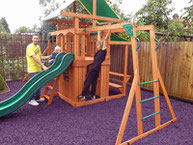Installers of children's safe play areas
Considerations and ideas for an outdoor children's play area.

- In a large garden size isn't critical, however, location is, plan to install the play area where you can easily keep an eye on the children playing, without being over intrusive.
- In a small garden you might want to think about space for washing lines, dining areas and even space for the bins. Too late once you have spent money installing the safe play surface for the kids.
- If space allows this can be a great way of combining play and learning. Encouraging sowing, growing, harvesting and eating fresh fruit and veg. Gardening with children can be found on this page create a child's garden
- I have installed most of the usual play surface materials including bark, rubber mats and rubber chippings and can recommend them as safe and a reasonable cost. Whereas, the rubber playing surfaces you see in parks, schools and other public play areas cost considerably more. As they require specialist installation, coming in liquid form, poured onto a prepared surface, in the same way as concrete.
information about the best surfaces for safe play areas.
What's the safest surface?
Loose Materials correctly installed to the manufactures instructions are as safe and
much cheaper than the "pour in" type of impact absorbing surface. Sand, bark, wood or rubber chips all work well. However, loose materials will need raking out and topping up now and
again.
Falling from Height
Most accidents are caused by falls from slides, climbing frames and swings, etc. So if you are thinking of adding play structures at a fall height of 1500mm or over you will need to pay more attention to the surface of the play area under and around these play structures.
A look at the facts about Impact Absorbing Surfaces
Here's some
information about Impact Absorbing Surfaces
This research paper prepared for the UK Health and Safety Executive by Professor David Ball (http://www.hse.gov.uk/research/) is worth reading.
Quote taken from the report "Amongst other things, it found that the effectiveness of impact absorbing surfaces in injury prevention is limited and there is little scientific evidence to support the claims made for it. Especially in long-bone fractures resulting from body weight descending on the limb or an awkward fall. It may reduce the severity of certain types of fall, for example, onto a joint. It may reduce the severity of the relatively rare head injuries".
Although trips and falls are an everyday part of the growth and development of our kids and we don't want to cover our kids in cotton wool before sending them out to play in the garden. This should not mean we would not want to make our gardens children friendly.
Falling from Height
According to The Royal Society for the Prevention of
accidents, the most common accidents are caused from falling from slides, climbing frames, swings, etc. So if you are thinking of adding play structures where
a child is playing at a fall height of 1500mm or over you will need to pay more attention to the surface of the play area under and around these play structures. More about suitable playground
surfaces on this page.
Play surface materials suitable up to a playing height up to 1500mm
Loose Materials correctly installed to the manufactures instructions, are as safe and much cheaper than the "pour in" type of impact absorbing surface. Sand, bark, wood or rubber chips all work well but, will need raking out and topping up now and again
Wood bark or chips marketed as play bark, drains well but also absorbs a lot of water, so feels wet for some time after rain. It degrades over time so needs topping up regularly and will also need raking now and then as it will compact. The small bits can stick to clothing and be carried into the house. More about depth and cost here play bark surface.
Rubber chips made from old car tyres, doesn't degrade, drains really well, comes in a choice of colours and wont compact as easily as bark and costs about the same. Rubber chip play surface.
Each mat is 1500mm x 1000mm x 23mm thick, covering 1.5m2 . The mats are made out of high quality recycled rubber, Installation is simple, just follow the simple instructions.
Grass with at least 150mm of sub soil is a very suitable surface for falls up to a height of 1500mm.
Grass is popular choice for children's play areas in the garden because it is a natural material and has some strong developmental value for children, especially if mixed with wild flower seeds.
Allowing the grass to grow longer helps to retain moisture in the soil, keeping the surface softer and safer. During dry spells the turf can break up so it's a good ideal to keep it watered.
In freezing weather the turf can become quite hard, meaning the Kids may have to give it a miss until it thaws out. Although a study did find little difference between grass, rubber and bark in freezing conditions.
Rubber mats are the best and the easiest material to use for a safe play surface outside
Heavy Duty Rubber mat 1.5m x 1.0m
Safety Floor under swings, playground equipment
Rapra Tested with a critical fall height of 3m!
Sold to councils up and down the UK
Grass grows through the rubber mats and can be mowed!
More information about surfaces and materials for outdoor kids safe play areas
What about building a Boules court for you and the kids
Play bark, play bark surfaces
Rubber chippings, rubber chippings surface
Synthetic turf, artificial grass
Combining gardening and play, create a child's garden.
Sensory gardens for children Sensory garden design
Writing your first book or novel? This new website provides advice and tips to help write, edit, publish, market and promote it https://www.faircop.com/

